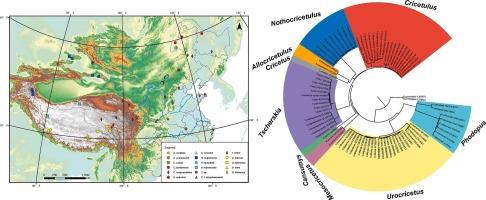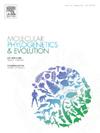Phylogenomic analyses of hamsters (Cricetinae) inferred from GBS data and mitochondrial genomes
IF 3.6
1区 生物学
Q2 BIOCHEMISTRY & MOLECULAR BIOLOGY
引用次数: 0
Abstract
Accurate species delimitation and identification is crucial for species conservation, providing a foundation for studies on evolutionary biology, ecology, and essentially all biological disciplines. The subfamily Cricetinae (Cricetidae, Rodentia), known as hamsters, is widely distributed in the Palearctic region. At present, there are nine genera and 18 species of hamsters are recognized worldwide, although the taxonomic status of certain taxa remains unclear. In this study, we collected 146 hamster specimens representing 14 species and generated new mitochondrial genomes and nuclear genome-wide single nucleotide polymorphisms (SNPs) to explore their relationships among these hamsters using multiple species delimitation approaches. Results showed: (1) strong phylogenetic support for the classification of Urocricetus, Nothocricetulus, and Cansumys as separate genera; (2) Urocricetus contained two separate species, U. kamensis and U. lama, with U. alticola and U. tibetanus considered synonyms of U. lama; (3) U. kamensis and U. lama are separated by the Nujiang River, with the matching divergence time suggesting that the formation of the river was the primary evolutionary factor driving the species differentiation, and (4) genetic differentiation occurred within the Tscherskia genus, which included two cryptic species.

根据 GBS 数据和线粒体基因组推断的仓鼠(Cricetinae)系统进化分析。
准确的物种划分和鉴定对于物种保护至关重要,它为进化生物学、生态学以及基本上所有生物学科的研究提供了基础。仓鼠亚科(Cricetinae,Rodentia)被称为仓鼠,广泛分布于古北地区。目前,全世界公认的仓鼠有 9 属 18 种,但某些类群的分类地位仍不明确。在这项研究中,我们收集了代表 14 个种的 146 只仓鼠标本,并生成了新的线粒体基因组和核基因组单核苷酸多态性(SNPs),利用多种物种划分方法探讨了这些仓鼠之间的关系。结果显示(1) Urocricetus、Nothocricetulus 和 Cansumys 作为独立属的分类得到了强有力的系统发育支持;(2) Urocricetus 包含两个独立的种,即 U. kamensis 和 U. lama,其中 U. alticola 和 U. tibetanus 被认为是 U. lama 的异名;(3) U. kamensis 和 U. lama 被怒江大峡谷分隔开来。lama 被怒江分隔开来,两者的分化时间相吻合,表明怒江的形成是物种分化的主要进化因素;(4)Tscherskia 属内部发生了遗传分化,其中包括两个隐性物种。
本文章由计算机程序翻译,如有差异,请以英文原文为准。
求助全文
约1分钟内获得全文
求助全文
来源期刊
CiteScore
7.50
自引率
7.30%
发文量
249
审稿时长
7.5 months
期刊介绍:
Molecular Phylogenetics and Evolution is dedicated to bringing Darwin''s dream within grasp - to "have fairly true genealogical trees of each great kingdom of Nature." The journal provides a forum for molecular studies that advance our understanding of phylogeny and evolution, further the development of phylogenetically more accurate taxonomic classifications, and ultimately bring a unified classification for all the ramifying lines of life. Phylogeographic studies will be considered for publication if they offer EXCEPTIONAL theoretical or empirical advances.

 求助内容:
求助内容: 应助结果提醒方式:
应助结果提醒方式:


